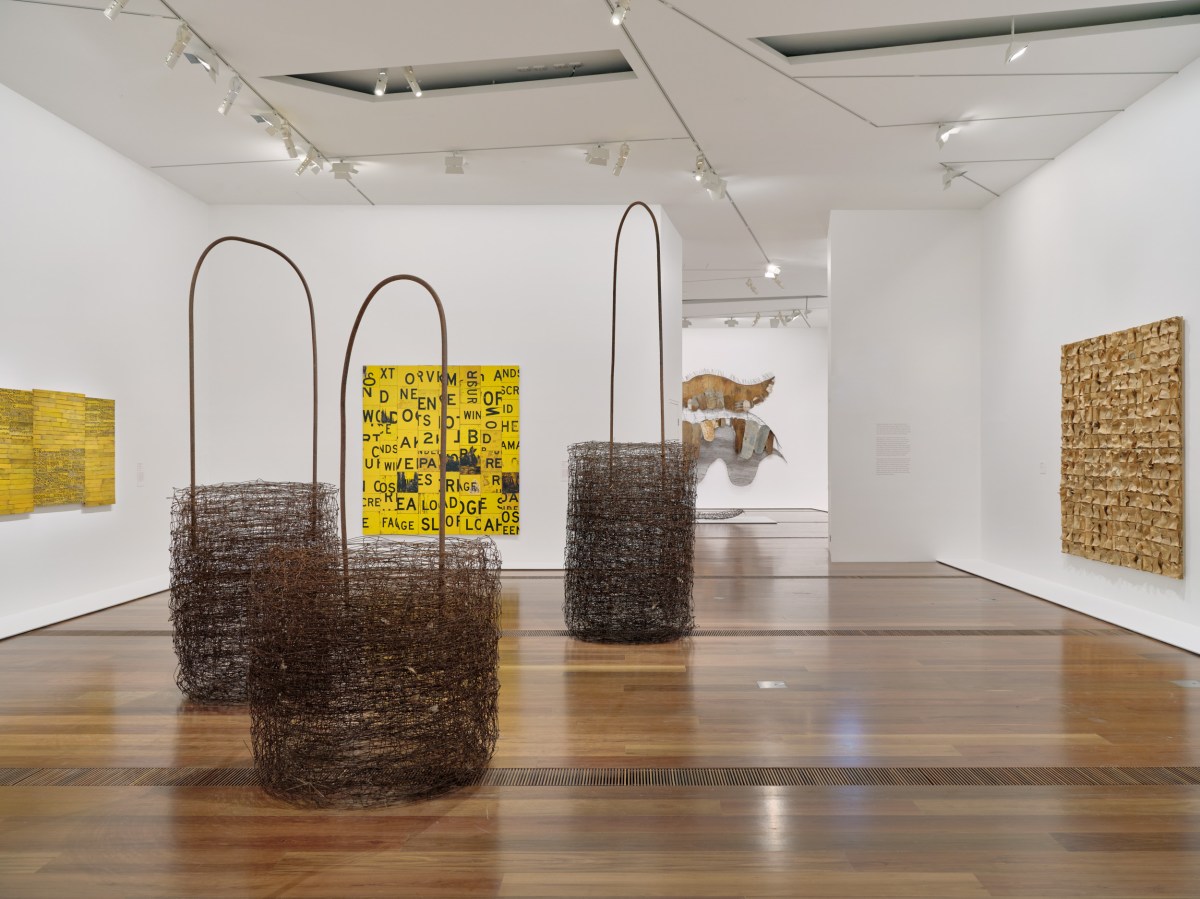Three quarters of the way through the exhibition Found and Gathered: Rosalie Gascoigne| Lorraine Connelly-Northey, currently showing at the NGV Ian Potter, is the installation of A Possum skin cloak: On Country, 2017 by Connelly-Northey: it acts as a great metaphor for the similarities and differences between the two artists’ work and an appropriate visual reference for the way the exhibition snakes and winds itself, river-like, through the different gallery spaces. Representing the Murray River between Albury and Wodonga as it twists and turns, connecting and separating, the juxtaposition of these two artists highlights their common sense of materiality but very different conceptual approaches.
Made from barbed wire, the huge snake slithers along wall and floor, surrounded by pressed tin and burnt corrugated iron koolimans (carrying vessel), tin canoes, boomerangs, wire gathering bags and mussel shells; a potent symbol for the water, the land, the culture and the passing of time.
Read: Exhibition review: Jeremy Deller: Father and Son
Curated by Beckett Rozentals and Myles Russell-Cook Found and Gathered is the first paired exhibition of the current series to focus on two women artists, drawing works from the NGV and private collections as well as other major public institutions in Australia.
In the gallery foyer where the exhibition begins, the positioning of two works associated with water hints at the conversation about to unfold. While both artists have been inspired by water, the focus of Rosalie Gascoigne’s Inland Sea, 1986, is on the poetry in nature and the landscape. Made from weathered painted corrugated iron and wire, it depicts squares of corrugated iron floating above fine wire bases in a grid-like structure, later to become an iconic aspect of the artist’s work, to emulate the gentle lapping of waves. Sitting alongside this piece is Lorraine Connelly Northey’s Fish trap, 2005 – 13 in which she also uses discarded industria such as rusty barbed wire and iron. Suspended, mobile-like, the work is a recreation of the traditional trap made from interwoven sticks and branches which would be used to form a dam wall to capture water life; the symbol of the hanging fish alongside the work giving it context while the work itself, although a celebration of culture, is also a critique on its destruction.
Though they have never met, these artists (both untrained) have conversations back and forth across generations through their works, They find a common voice through the repurposing of discarded elements of industrialisation and the urbanisation of the environment. Gascoigne was originally from New Zealand and immigrated to Australia in the early 1940s while Connelly Northey, born in 1962, is from a mixed-race heritage.
Inspired by the natural world, Gascoigne created abstract assemblages of landscapes from what she could find in her local terrain, such as wood, iron, wire, feathers and reflective road signs while Connelly Northey’s trips to gather refuse such as corrugated iron and barbed wire along with feathers, berries and wood are used to recreate traditional objects such as woven vessels and koolimans. Her works are a protest to indigenous dispossession and the ongoing pain of colonisation.
Carefully designed gallery spaces are wheelchair accessible and exude a sense of calm, allowing the visitor time to contemplate the pieces on display. Supporting the artwork are text labels and didactic panels, however; the earthy light brown text which complements the works on display may cause some discrimination difficulty for people with visual impairments.
Pink window, 1975, made from painted wood and corrugated galvanised iron by Gascoigne, speaks of the loneliness and isolation she sometimes felt in the emptiness and vastness of the Australian landscape. Takeover bid, 1981, created from found window frames and thistle stems, extends the concept of looking onto the landscape but this time through a lyrical eye in which the patterning of the thistle stems and connection with the natural world is celebrated.
Connelly Northey’s A Possum Skin Cloak: Hunter’s Duck net, 2021, also makes use of rusted corrugated iron, rusted fence wire, tin and copper wire. Touching on the water theme and the majesty of this ancient landscape, she depicts, in narrative form, a net stretched between two great river red gums, a traditional means of capturing ducks flying overhead using the boomerang.
Despite Connelly Northey’s objection to the association of beauty with her artwork, the skillful manipulation and repurposing of often harsh materials into traditional objects reflects a beauty through her play on form, balance and combination of materials. The narrbong (string bags) and koolimans made from wire and wire mesh, driftwood and feathers (2002 – 2005) and housed in glass cabinets along one of the gallery walls are aesthetically pleasing to the eye while tapping into a sense of the precious. These are beautiful objects to behold.
In another space, the narrbong metamorphises from the small and precious to large sculptural objects in Wire bag, I, II, III, 2013, made from rusted steel and fence wire. The size of the pieces are a statement about the scale of destruction to not only cultural heritage but families and communities kept out of Country.
Although Gascoigne’s minimal abstract landscape pieces also convey an element of the precious in nature, works such as All Summer long, 1996, an assemblage made from the sawn painted and stenciled wood from soft drink boxes, references not only the long hot Australian summers but celebrates a joy in the patterns and rhythms found in the natural world through the interplay of text and painted yellow background.
A sensitively curated and designed exhibition that captures the voices of these two wonderful Australian artists through the power and pairing of their works.
Found and Gathered is a free exhibition, NGV, Ian Potter
This is a free exhibition.
Visitors 16 years and over must be fully vaccinated against COVID-19 or have a valid medical exemption in line with the Chief Heath Officer’s directions.
Masks are currently required when visiting the NGV design store only.





